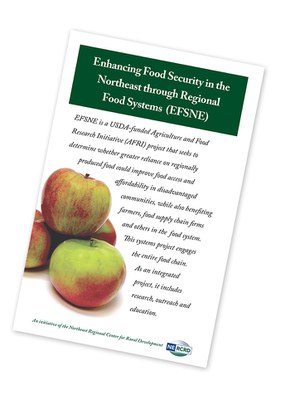 Context
Context
Over 7 million Northeast citizens are food insecure. Low-income communities are disproportionately affected by lack of access to healthy, affordable foods. Families in those communities face many barriers to achieving food security. Challenges to food security for everyone in the region also come from climate change, farmland loss, and sourcing most of our food from outside our region. We believe that in terms of food access, low income populations do not exist in a vacuum. The availability of and access to food for disadvantaged populations in the future is tied to the region's ability to produce and distribute a significant share of the foodstuffs needed by the entire population.
Overall Project Goal
The overall project goal is to determine whether greater reliance on regionally produced food could improve food access in low-income communities, while also benefiting farmers, food supply chain firms and others in the food system. There are five objectives guiding the work of the project.
Our Approach
This is a multi-disciplinary systems project - engaging the entire food chain from production to consumption in a collaborative effort among nine teams.
The project focuses on 13 low-income community sites within nine locations across the Northeast, defined as 12 states from Maine to WV and the District of Columbia. The focal point of all of the research teams is a full-diet market basket of eight foods that are or can be produced or processed in the Northeast states in significant quantities. These are milk, bread, ground beef, potatoes, apples, cabbage, canned peaches and frozen broccoli.
We worked within our partner communities across the Northeast to assess current and potential community level constraints and opportunities for improving access to regionally produced healthy food for people in these communities. Our Consumption Team is guiding this work.
Working with these community sites, we identified and assessed appropriate food supply chain practices in low-income areas of the Northeast, comparing site-specific, regional, and global chains, and identifying policy interventions. Our Distribution Team is guiding this work.
We also are working to assess the overall capacity of the Northeast to satisfy more of its food needs, using large-scale GIS analyses across the nearly 300 counties in the Northeast. This assessment will consider production capacity, including climate and soil suitability for different crops, as well as of food processing infrastructure, distribution channels, retail stores, and consumption preferences. Our Production Team is guiding this work.
Throughout the work of this project, the team has developed multiple models. Our Scenarios and Modeling Team is guiding and integrating the project's modeling work to provide a coherent, trans-disciplinary analysis of the potential of a regional food system to enhance food security in the Northeast.
How is our project unique?
The project is unique and significant in three ways.
- The focus is explicitly on the regional rather than national or local level. The regional scale -- which incorporates local aspects -- may be optimal for assuring adequate and affordable food supplies over time.
- It will take a systems approach that links production, distribution and consumption processes in a deliberate and logical way to expand knowledge and understanding of these complex systems and support action on the ground in our partner communities.
- The project develops and integrates innovative research methods. It will develop models to study these complex systems, including future production, distribution and consumption scenarios. This project will help us propose and test promising avenues for improving food access in disadvantaged northeast communities and elsewhere.

